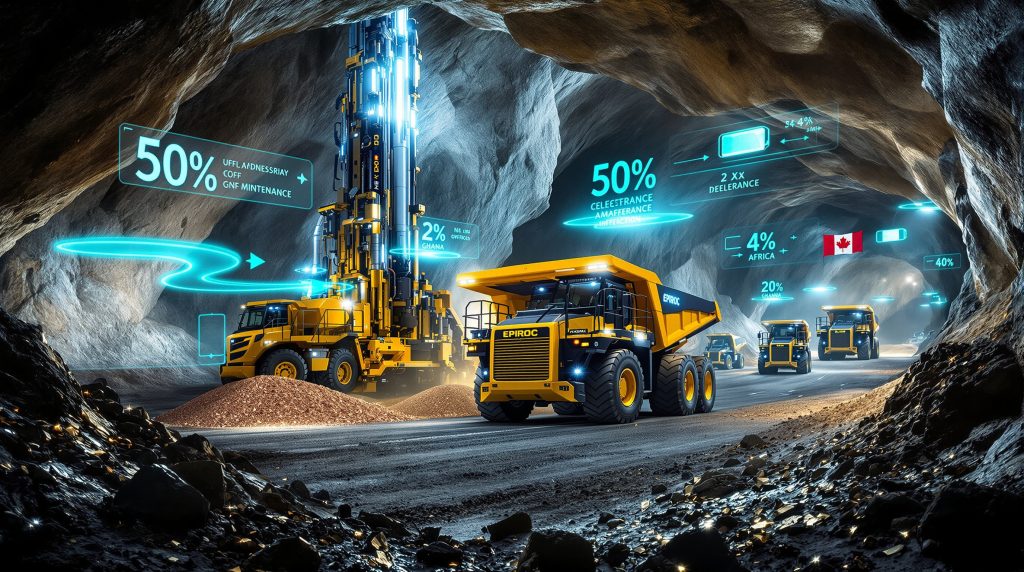Revolutionary Mining Electrification Through Strategic Partnerships
The mining industry stands at a critical juncture as environmental pressures and operational efficiency demands drive unprecedented changes in equipment technology. Epiroc expands battery-electric mining equipment through strategic partnerships represents a significant shift toward sustainable underground operations, with the company recently announcing enhanced distribution capabilities for specialised electric equipment including scalers and mobile rescue chambers.
This transformation extends beyond simple equipment replacement, encompassing comprehensive operational restructuring that addresses ventilation costs, worker safety, and long-term sustainability goals. The integration of battery-electric technology with autonomous systems creates new possibilities for mining efficiency while reducing environmental impact in confined underground environments. Furthermore, these developments align with broader industry evolution trends shaping the sector's future.
Strategic Partnership Model Driving Equipment Innovation
Epiroc's collaboration with Sweden-based Jama Mining Machines exemplifies the industry's shift toward specialised manufacturing partnerships. This strategic alliance focuses on expanding the availability of battery-electric scalers, specifically the SBU 8000 E model, alongside mobile rescue chambers designed for emission-free underground operations.
The partnership model represents a broader trend in mining equipment manufacturing, where established companies leverage specialised manufacturers' expertise to accelerate product development and market penetration. This approach allows for:
• Rapid deployment of proven battery-electric technologies
• Access to specialised engineering expertise in niche equipment categories
• Reduced development timelines for new product categories
• Enhanced service and support networks across global markets
Sweden's position as a leader in sustainable mining technology development makes this partnership particularly strategic. The country has implemented some of the world's most stringent environmental regulations for underground mining operations. Additionally, the Epiroc partnership expansion demonstrates the company's commitment to broadening its electric equipment portfolio through strategic alliances.
Market Leadership in Electrification
The technical expertise developed in this regulatory environment provides valuable insights for global applications. Moreover, advances in electric vehicles in mining demonstrate the transformative potential of electrification across various mining applications.
Comprehensive Equipment Portfolio Transformation
The expansion into battery-electric mining equipment encompasses multiple critical categories essential for underground operations. Rock scaling equipment represents a particularly important application, as these machines operate in close proximity to workers and require frequent repositioning throughout mining areas.
Underground Safety Equipment Evolution
The SBU 8000 E battery-electric scaler addresses several operational challenges simultaneously. Traditional diesel-powered scalers generate significant heat and emissions in confined spaces, requiring extensive ventilation systems to maintain safe working conditions. Battery-electric alternatives eliminate these concerns while providing:
• Reduced heat generation in underground environments
• Elimination of diesel exhaust requiring ventilation management
• Lower noise levels improving worker communication and safety
• Enhanced manoeuvrability in tight underground spaces
Mobile rescue chambers equipped with electric propulsion systems represent another critical safety advancement. These units must remain operational during emergency situations when ventilation systems may be compromised, making emission-free operation essential for crew safety during evacuation procedures.
Material Handling Technology Integration
The broader equipment transformation extends to core mining operations including drilling, loading, and hauling systems. Battery-electric load-haul-dump equipment offers particular advantages in underground environments where air quality directly impacts worker health and operational efficiency.
Modern battery-electric systems provide instant torque delivery, enabling more precise control during loading operations and reducing material spillage. The elimination of diesel engines also removes heat sources that can contribute to underground temperature management challenges. Consequently, this becomes particularly significant in deeper mining operations where geothermal heating presents additional challenges.
Operational Efficiency and Cost Transformation
The economics of battery-electric mining equipment involve complex calculations extending beyond simple fuel cost comparisons. Underground operations face unique challenges where electric equipment advantages become particularly pronounced. In addition, the decarbonisation benefits extend far beyond immediate operational improvements.
Ventilation System Cost Impact
Underground ventilation represents one of the largest operational expenses in modern mining, often consuming 25-40% of total mine electrical consumption. When Epiroc expands battery-electric mining equipment, it significantly reduces ventilation requirements by eliminating diesel exhaust, allowing mines to:
• Reduce ventilation system power consumption
• Optimise air flow patterns for cooling rather than exhaust management
• Implement more efficient ventilation designs in new mine developments
• Reduce infrastructure requirements for air shaft construction
Maintenance Complexity Reduction
Electric motors contain significantly fewer moving parts compared to diesel engines, translating to extended maintenance intervals and reduced complexity. Underground maintenance operations face unique challenges including:
• Limited access for heavy equipment transport
• Restricted workspace for maintenance activities
• Higher labour costs due to underground work premiums
• Extended downtime costs when equipment requires surface maintenance
Battery-electric systems address these challenges through simplified maintenance requirements and improved component accessibility. Diagnostic systems integrated with electric powertrains provide real-time performance monitoring, enabling predictive maintenance scheduling that minimises unexpected failures.
Technical Implementation Challenges and Solutions
The transition to battery-electric mining equipment faces several technical hurdles that require innovative engineering solutions. Underground environments present unique challenges for battery technology including temperature extremes, humidity, and operational duty cycles. However, insights from battery-grade lithium insights inform the development of more robust energy storage solutions.
Power Distribution Infrastructure Requirements
Underground electrical infrastructure must be upgraded to support high-power charging systems while maintaining safety standards for explosive atmospheres. Modern mines require:
• High-capacity power distribution systems capable of handling charging loads
• Explosion-proof electrical equipment meeting underground safety standards
• Redundant power supplies ensuring equipment availability during electrical maintenance
• Integration with existing mine power management systems
Battery Technology Optimisation
Mining applications demand battery systems capable of sustained high-power output during intensive operational periods. Current lithium-ion technology provides adequate energy density for most underground applications, but continued development focuses on:
• Extended operational range through improved energy density
• Faster charging capabilities reducing equipment downtime
• Enhanced thermal management for underground temperature conditions
• Robust construction capable of withstanding mining environment stresses
Equipment Integration Complexity
Integrating battery-electric powertrains with existing hydraulic and mechanical systems requires careful engineering to maintain operational performance. Key considerations include:
• Hydraulic system power requirements during peak operational demands
• Weight distribution changes affecting equipment stability and performance
• Control system integration ensuring seamless operator experience
• Service accessibility for routine maintenance and battery replacement
Furthermore, the integration of AI in drilling innovation with electric equipment creates additional opportunities for operational optimisation.
Global Market Expansion and Manufacturing Strategy
The success of battery-electric mining equipment depends on establishing robust manufacturing and support networks capable of serving diverse global markets. Regional manufacturing capabilities become essential for managing costs, delivery timelines, and local content requirements.
Regional Manufacturing Development
Establishing local manufacturing capabilities provides several strategic advantages including reduced transportation costs, faster delivery timelines, and compliance with local content requirements common in mining jurisdictions. This approach also enables:
• Customisation for regional geological conditions and mining practices
• Local workforce development supporting long-term market presence
• Reduced currency exposure through local cost structures
• Enhanced customer relationships through regional presence
Technology Transfer and Workforce Development
The transition to electric mining equipment requires significant workforce retraining and skill development. Traditional diesel mechanic skills must be supplemented with electrical system knowledge, battery management expertise, and high-voltage safety procedures.
Training programmes must address both technical competencies and safety protocols specific to battery-electric systems. Underground environments present unique challenges for electrical equipment maintenance, requiring specialised knowledge of:
• High-voltage safety procedures in confined spaces
• Battery system diagnostics and troubleshooting
• Charging infrastructure maintenance and safety protocols
• Emergency response procedures for electrical system failures
Recent developments showcase significant momentum in the sector, with Epiroc's major Canadian mining contract demonstrating growing market acceptance of electric mining solutions.
Environmental Regulatory Drivers and Market Evolution
Government regulations increasingly focus on underground air quality standards and emissions reduction targets, creating market drivers favouring electric equipment adoption. These regulatory pressures vary significantly across mining jurisdictions but show consistent trends toward stricter environmental standards.
Jurisdictional Regulatory Variations
Different mining regions implement varying approaches to environmental regulation, creating complex compliance requirements for international mining companies. Key regulatory trends include:
• Stricter particulate matter limits in underground environments
• Carbon pricing mechanisms affecting diesel fuel costs
• Workplace safety standards emphasising air quality improvements
• Environmental impact assessment requirements for new mine developments
Corporate ESG Compliance Requirements
Institutional investors increasingly evaluate mining companies based on Environmental, Social, and Governance (ESG) criteria, creating financial incentives for sustainable technology adoption. These requirements drive:
• Public reporting of carbon emissions and reduction targets
• Supply chain transparency requirements affecting equipment selection
• Worker health and safety performance metrics
• Long-term sustainability planning and capital allocation
The comprehensive decarbonisation benefits demonstrate the economic advantages of transitioning to sustainable mining practices.
Future Technology Development and Market Projections
The evolution of battery-electric mining equipment continues through ongoing research and development focused on addressing current limitations and expanding application ranges. Future developments will likely focus on autonomous system integration, advanced battery technologies, and comprehensive fleet management capabilities.
Autonomous System Integration
The combination of battery-electric powertrains with autonomous operation capabilities creates opportunities for continuous mining operations with minimal human intervention in hazardous areas. Future developments may include:
• Fully autonomous equipment fleets operating continuously during shift changes
• Remote operation centres managing multiple mine sites simultaneously
• Artificial intelligence optimisation of equipment deployment and energy management
• Integrated safety systems preventing equipment-personnel interactions
Advanced Battery Technology Applications
Next-generation battery technologies under development promise significant improvements in energy density, charging speed, and operational lifespan. Solid-state battery technology shows particular promise for mining applications due to:
• Higher energy density enabling extended operational range
• Improved safety characteristics reducing fire and explosion risks
• Enhanced performance in extreme temperature conditions
• Longer lifespan reducing total cost of ownership
Market Integration and Infrastructure Development
The widespread adoption of battery-electric mining equipment will require coordinated infrastructure development and industry standardisation. Future market evolution may include:
• Standardised charging interfaces enabling equipment interoperability
• Renewable energy integration for carbon-neutral mining operations
• Battery recycling programmes supporting sustainable lifecycle management
• Industry-wide training and certification programmes for electric equipment maintenance
The transformation of underground mining through battery-electric technology represents a fundamental shift toward sustainable operations that balance environmental responsibility with operational efficiency. Strategic partnerships demonstrate the industry's commitment to accelerating this transition while addressing complex technical and economic challenges.
As regulatory pressures intensify and technology continues advancing, when Epiroc expands battery-electric mining equipment adoption, it will likely accelerate across global mining operations. The success of early implementations will provide valuable data supporting broader industry transformation, ultimately leading to safer, more efficient, and environmentally responsible mining practices worldwide.
Note: The mining equipment industry continues evolving rapidly, and specific technical specifications, financial projections, and market developments mentioned in this analysis should be verified with current manufacturer documentation and industry reports for the most accurate information.
Ready to Capitalise on Sustainable Mining Technology Innovations?
Discovery Alert's proprietary Discovery IQ model delivers real-time alerts on significant mining technology and sustainability discoveries, instantly empowering subscribers to identify actionable opportunities ahead of the broader market. Begin your 30-day free trial today and secure your market-leading advantage.




